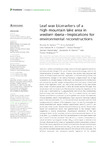Mostrar o rexistro simple do ítem
Leaf Wax Biomarkers of a High-Mountain Lake Area in Western Iberia—Implications for Environmental Reconstructions
| dc.contributor.author | Santos, Ricardo N. | |
| dc.contributor.author | Schefuß, Enno | |
| dc.contributor.author | Cordeiro, Lívia | |
| dc.contributor.author | Oliveira, Dulce | |
| dc.contributor.author | Hernández, Armand | |
| dc.contributor.author | Ramos, Alexandre M. | |
| dc.contributor.author | Rodrigues, Teresa | |
| dc.date.accessioned | 2023-04-20T15:12:01Z | |
| dc.date.available | 2023-04-20T15:12:01Z | |
| dc.date.issued | 2022-11-29 | |
| dc.identifier.citation | Santos RN, Schefuß E, Cordeiro LGMS, Oliveira D, Hernández A, Ramos AM and Rodrigues T (2022) Leaf wax biomarkers of a high-mountain lake area in western iberia—Implications for environmental reconstructions. Front. Environ. Sci. 10:994377. doi: 10.3389/fenvs.2022.994377 | es_ES |
| dc.identifier.issn | 2296-665X | |
| dc.identifier.uri | http://hdl.handle.net/2183/32893 | |
| dc.description | This article is part of the Research Topic Women in Biogeochemical Dynamics Research: 2022 | es_ES |
| dc.description | The Supplementary Material for this article can be found online at: https://www.frontiersin.org/articles/10.3389/fenvs.2022.994377/full#supplementary-material | es_ES |
| dc.description.abstract | [Abstract] Leaf wax n-alkane biomarkers are widely used to infer past vegetation dynamics and hydroclimate changes. The use of these compounds strongly relies on the characterization of modern plants. However, few studies have explored leaf waxes of modern plants and their application to reconstructing climate and environmental changes in the Iberian Peninsula, a region known for its high vulnerability to climate change. In this study, we characterize the distributions and compound-specific isotopic compositions of the leaf waxes of dominant plants in the vegetation cover, soil, and surface sediment of the Lake Peixão area, a high-mountain glacial lake in Serra da Estrela (central Portugal). Our results show that the modern oro-Mediterranean (subalpine) vegetation of the study area is dominated by C3 grasses/herbs and shrubs that preferentially produce long-chain leaf waxes (≥C27). The C31 n-alkane display the overall highest concentration, produced by some grasses and shrubs, but especially Erica sp (heather), which is highlighted as a major source for the total n-alkane pool in the lake sediments. C29 is the second-most abundant and the most equally produced n-alkane of the vegetation cover; C25 and C27 homologs are mainly associated with aquatic-related grasses/herbs, while C33 and C35 are particularly linked to cold-drought tolerant Juniperus sp. shrubs. Shrubs show higher but proportional values than grasses/herbs in the isotopic space, suggesting a directly proportional physiological adaptation of the two ecological forms to the prevailing climatic and environmental factors of the study area. C29 is pointed as the most representative (or less plant-biased) leaf wax n-alkane in the lake sediments. Thus, δD of C29 n-alkane is interpreted as a robust terrestrial hydrological indicator (δDterr), which signal is believed to be strongly influenced by the mean air temperature and/or precipitation amount. Despite the sparse vegetation and small catchment area, the apparent hydrogen fractionation factor, determined from δDterr of the lake surface sediment, is in line with the modeled global mean values for the latitude of the study area. The different molecular and compound-specific signatures of the studied oro-Mediterranean species have the potential to support future interpretations of leaf wax biomarkers in the Iberian Peninsula. | es_ES |
| dc.description.abstract | Graphical abstract: https://www.frontiersin.org/files/Articles/994377/fenvs-10-994377-HTML/image_m/FENVS_fenvs-2022-994377_wc_abs.jpg | es_ES |
| dc.description.sponsorship | This work has been supported by the Portuguese Foundation for Science and Technology–FCT, through the HOLMODRIVE project (PTDC/CTA494 GEO/29029/2017). The authors would like to express their gratitude for the data and contributions to the following projects/institutions: WarmWorld (PTDC/CTA-GEO/29897/2017), IF/01489/2015, EMSO-PT–INFRA/22157/2016, CCMAR UIDB/04326/2020, UIDP/04326/2020, LA/P/0101/2020, DO thanks to FCT through the contract CEECIND/02208/2017. AH thanks to the Spanish Ministry of Science and Innovation through the Ramón y Cajal Scheme (RYC2020–501 029253-I) | es_ES |
| dc.description.sponsorship | Portugal. Fundação para a Ciência e a Tecnologia; PTDC/CTA494 GEO/29029/2017 | es_ES |
| dc.description.sponsorship | Portugal. Fundação para a Ciência e a Tecnologia; PTDC/CTA-GEO/29897/2017 | es_ES |
| dc.description.sponsorship | Portugal. Fundação para a Ciência e a Tecnologia; IF/01489/2015 | es_ES |
| dc.description.sponsorship | Portugal. Fundação para a Ciência e a Tecnologia; EMSO-PT–INFRA/22157/2016 | es_ES |
| dc.description.sponsorship | Portugal. Fundação para a Ciência e a Tecnologia; CCMAR UIDB/04326/2020 | es_ES |
| dc.description.sponsorship | Portugal. Fundação para a Ciência e a Tecnologia; UIDP/04326/2020 | es_ES |
| dc.description.sponsorship | Portugal. Fundação para a Ciência e a Tecnologia; LA/P/0101/2020 | es_ES |
| dc.description.sponsorship | Portugal. Fundação para a Ciência e a Tecnologia; CEECIND/02208/2017 | es_ES |
| dc.description.uri | https://www.frontiersin.org/articles/10.3389/fenvs.2022.994377/full#supplementary-material | |
| dc.language.iso | eng | es_ES |
| dc.publisher | Frontiers | es_ES |
| dc.relation | info:eu-repo/grantAgreement/AEI/Plan Estatal de Investigación Científica y Técnica y de Innovación 2017-2020/RYC2020-029253-I/ES/ | es_ES |
| dc.relation.uri | https://doi.org/10.3389/fenvs.2022.994377 | es_ES |
| dc.rights | Atribución 4.0 Internacional | es_ES |
| dc.rights.uri | http://creativecommons.org/licenses/by/4.0/ | * |
| dc.subject | Leaf wax n-alkanes | es_ES |
| dc.subject | Terrestrial biomarkers | es_ES |
| dc.subject | Stable isotopes | es_ES |
| dc.subject | Western Iberia | es_ES |
| dc.subject | High-mountain lake | es_ES |
| dc.title | Leaf Wax Biomarkers of a High-Mountain Lake Area in Western Iberia—Implications for Environmental Reconstructions | es_ES |
| dc.type | info:eu-repo/semantics/article | es_ES |
| dc.rights.access | info:eu-repo/semantics/openAccess | es_ES |
| UDC.journalTitle | Frontiers in Environmental Science | es_ES |
| UDC.volume | 10 | es_ES |
| UDC.startPage | 994377 | es_ES |
| dc.identifier.doi | 10.3389/fenvs.2022.994377 |
Ficheiros no ítem
Este ítem aparece na(s) seguinte(s) colección(s)
-
GI-GRICA - Artigos [49]






